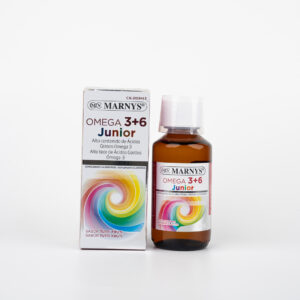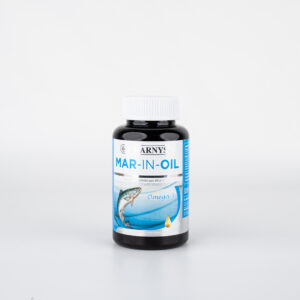What are fatty acids?
Omega-3 fatty acids are bioactive molecules what have a dual function in our body. They provide energy to act as regulators of vital metabolic processes. There are two types of polyunsaturated fatty acids that are indispensable for the body’s metabolic processes: linoleic acid (LA) and alpha-linoleic acid (ALN).They are known as essential fatty acids (EFAs).
Fatty acids are divided into 3 groups: saturated, monounsaturated and polyunsaturated. Within the polyunsaturated fatty acids (PUFAs) we find two essential fatty acids that are indispensable for the body’s metabolic processes. The body cannot synthesize and must be supplied through our diet: linolenic acid (omega-3) and linoleic acid (omega-6).
Cardioprotective and neuroprotective action
Extensive clinical and epidemiological studies demonstrated that long-chain polyunsaturated fatty acids contribute to optimal functioning of heart and brain functions.
The cardioprotective action of these fatty acids focuses on maintaining and normalising cholesterol and triglyceride levels, blood pressure, heart and vascular function, and inflammatory processes, hyperlipidemia (abnormally high lipid levels) and high blood pressure.In terms of neuroprotective action, they perform structural functions and impact on numerous processes of neuronal development and behaviour, including changes in learning, auditory memory and visual and olfactory responses.
Omega‐3 Fatty Acids for Cardioprotection
The American Heart Association (AHA) has endorsed the use of omega‐3 fatty acids for secondary prevention of cardiovascular events in people with documented coronary artery disease. The recommendation calls for approximately 1 g/d of a mixture of (DHA) and (EPA). Although the AHA statement identifies oily fish as the ideal source, fish oil (in capsules or liquid form) is also an acceptable option. This is the first time that the AHA has recommended a nutritional supplement for coronary artery disease (CAD) prevention. The omega‐3 fatty acid recommendation is based on an extensive and growing body of evidence supporting the cardiovascular benefits and triglyceride‐lowering effects of omega‐3 oils.
Another study, the Italian GISSI randomised 11.323 patients who had experienced a Myocardial infarction to omega‐3 acid ethyl esters (1 capsule/day, providing 850 mg of DHA and EPA) or usual care. Treatment significantly reduced risk of death from any cause by 28%; after 4 months, risk of sudden cardiac death (SCD) was decreased by 45%
Omega 3: EPA and DHA
Specifically, the atty acids called Omega such as DHA (Docosahexaenoic Acid) and EPA (Eicosapentaenoic Acid) are essential for proper organ functioning. For example, DHA fatty acid is an essential nutrient in the brain and retina. Both require high concentrations of DHA to provide optimal mental and visual performance.
Omega 3, essential for growth
At present, the WHO and many medical and scientific bodies (European and American Society of Cardiology) have established recommendations for an adequate intake of Omega 3. Both for the prevention and treatment of chronic diseases, especially cardiovascular. Thus, it has been demonstrated that, in people without previous cardiovascular disease, the intake of Omega 3 reduces the risk of suffering from it by more than 18% (Waitzberg, 2014).
An adequate supply of essential fatty acids in children and adults helps to prevent deficiencies and chronic diseases. Growth and aging are the two life stages when the nutritional level of Omega 3 is a very sensitive indicator. Its deficiency gradually compromises physical, functional, and cognitive aspects.
Omega 3 during pregnancy, breastfeeding, and childhood
Omega 3 is essential for children’s growth. In the fetus and newborn babies these nutrients are already essential for the nervous system. DHA is in the membranes of retinal and neuronal cells, being crucial for the transmission of information between neurons and the creation of new ones.
- During pregnancy and breastfeeding, the requirements of Omega 3, mostly depend on the mother. Studies have shown that the foetus accumulates about 65 mg of Omega 3 per day during the last trimester. During breastfeeding, mothers supply their babies with 80mg of Omega 3 per litre of milk produced. Therefore, newborn babies exceed the intake of pregnant and nursing women.
- This highlights a possible shortage for both mother and baby and emphasises the importance of improving the maternal levels of Omega 3 during pregnancy, breastfeeding and childhood (Carughi, 2010).
How do we obtain fatty acids for our body?
The EFSA (European Food Safety Authority) and American Heart Association dietary guidelines recommend 250-500 mg EPA + DHA per day. However, the human body is unable to synthesise these essential polyunsaturated fatty acids and, consequently, we rely on our diet and supplements to obtain them.
MARNYS OMEGA 3+6 JUNIOR SYR 125ML
MARNYS® JUNIOR OMEGA 3, 6 is a plant-based product that has a high omega-3 content with a balanced source of essential fatty acids: linoleic acid and α-linolenic acid. With tutti-frutti flavouring, in an easy-to-take liquid format.
MARNYS MAR-IN-OIL 150 CAP
MARNYS® Mar-INOIL Salmon Oil softgels provide vitamin E, which helps protect cells against oxidative stress. MAR- INOIL Salmon Oil guarantees that oil properties are non-toxic: achieving the correct contaminant, heavy metal, dioxin and furan levels.







